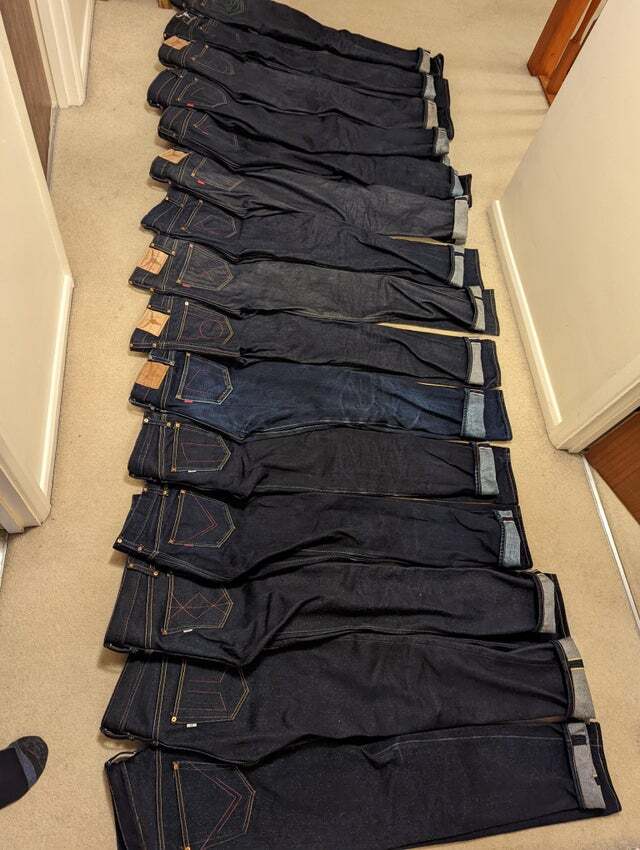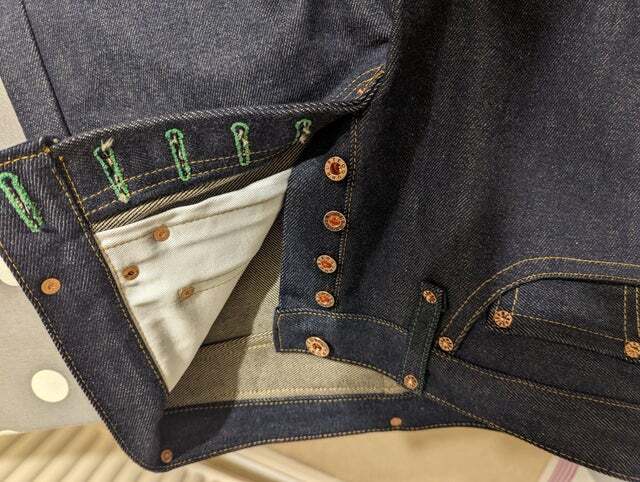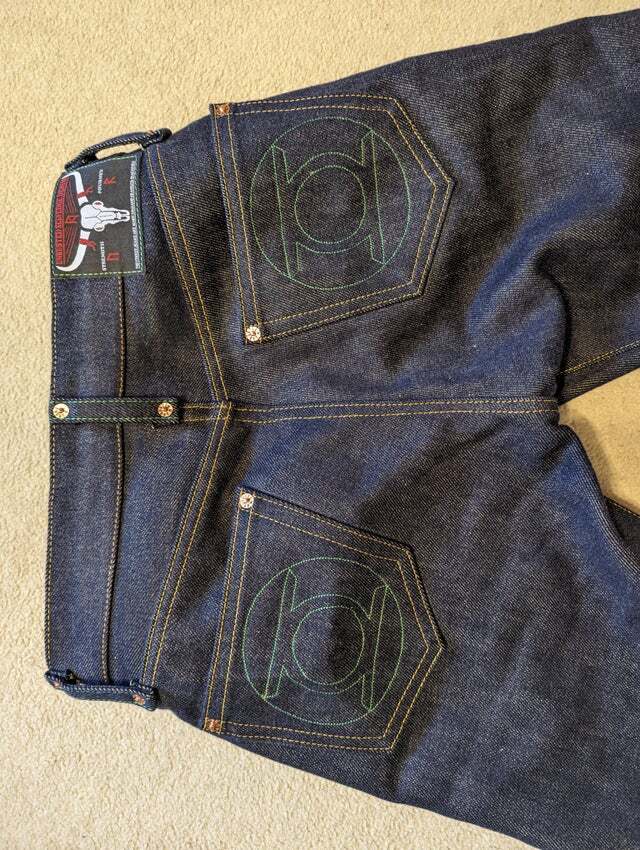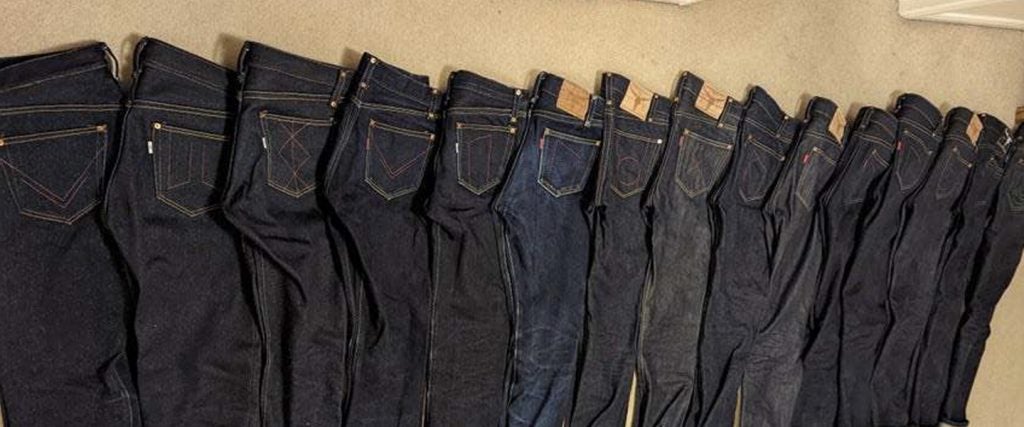For years, aerospace commodity engineer Andrew Jameson, 46, couldn’t find the perfect pair of jeans. Some were too big. Others were too small. And those that fit usually fell apart after a few rounds in the wash. So, in 2017, he set out on a four-year project that would end with him creating 16 versions of his own pair of hand-stitched denim jeans. This is his (very blue) story.

* * * * *
Like many American kids, I grew up in jeans. Mostly hand-me-downs from cousins. Or jeans that my parents bought second-hand with holes in the knees. Or jeans with pockets so worn out that they were tearing. Still, those jeans had all the right features that a kid needs: They were durable, easy to wash, and at that age, you’d grow out of them before they were worn out to the point of being unwearable.
I’ve loved wearing denim ever since. But as I grew older, I started to care more about fit. And the problem with jeans that you can buy off-the-shelf is that they never fit quite right. Sometimes they fit better when they’ve been worn down and washed. The denim starts to shrink and forms better to the body. By then, though, they look pretty ragged. I wanted jeans that fit perfectly from the start.
I experimented with tailoring off-the-shelf jeans, which was fine. But generally speaking, the quality of mass-produced denim has been steadily eroding. In 2017, the idea of creating my own jeans started to gain serious steam. I had plans to move my family back to the U.S. from the U.K. in 2020, so a couple of years before the planned move date, I wanted to collect something to take back that was British. What I decided on were antique sewing machines. I enjoy being around machines in general and sewing machines, in particular, are a piece of British history. Singer is an American manufacturer of sewing machines, but they used to have a factory up in Scotland so they’re cheap and easy to find in the U.K.
All the while, I was researching and studying as much as I could learn about jean construction and history, denim manufacturing, thread and dying. It took about two years of trial and error to figure out which machines worked best (or at all).
I’m an aerospace commodity manager, and I’ve been working with airplanes since the late 1990s. Sourcing is part of what I do at work and I already have suppliers of metals, plastics, rubber, etc., so I went looking in Europe, and across Southeast Asia, Japan, China, the Philippines, Malaysia and Thailand for all the materials I needed. Most suppliers don’t want to talk to you if you’re not going to place a large order, but most will accept sample orders from a small company. One thing that helped was mentioning that I was starting a small business and working on testing and development for making jeans.
About six months into the project, I took apart my second favorite pair of 501s — pulling every stitch, rivet and button out — while taking notes of the seam lines, fold marks and order in which I disassembled them. I called them my sacrifice pattern. That pair was used for the first 12 pairs of jeans I made. Each time I made adjustments to the patterns gauging for shrink and aesthetics until I felt I had them down for a perfect fit. Then I made new patterns and used those moving forward.

About two years into the project, I pulled on my first pair of jeans. I had a dozen thoughts running through my head about estimates, design liberties and blind guesses I’d made during that first construction. They were 23 ounces, sanforized selvedge denim jeans, and they felt like tent canvas tubes pinching the backs of my knees. In other words, they felt awesome.
Okay, the fit wasn’t great, and it took a half dozen pairs to systematically work out and refine the techniques and construction methods until they really started to fit well. But sliding on that first pair was a glorious moment for me.
I’ve made 16 pairs over the last few years. I’ve branded them all with the name “Unrusted.” When I was 23, I bought a 1967 Camaro, restored the car, dropped my college classes and packed everything I owned into the car and headed west. Labor Day weekend of 1998 I ended up in Tucson with my younger brother, and we watched a monsoon roll in across the sky. For the first time of my life, I really felt like I was home. Nothing really rusts in the desert — it gets faded and worn, but that rust doesn’t burrow in deep. So that’s where “Unrusted” came from — remembering home.
At the moment, I have a terrible business model for making jeans, mostly because everything is done by hand. Every stitch is cranked, every rivet peened and stamped. And the leather patch on the back is stamped using an automated programmable machining tool. I’d starve to death if I worked by the hour. It takes me three to four pretty heavy days to make a pair of 22-ounce denim jeans. The lighter denim (14.5 ounces) is faster since I don’t have to fight the denim as much, but it’s still a decent chunk of work.

If I can work out an acceptable compromise in construction methods for these jeans that enables them to be produced faster without sacrificing any of the quality, then I’d consider turning the project into a business.
Currently, I’m working on a manual to help others learn how to make jeans. My hope is that with my instructions as a guide, they’ll have an easier time making their way through the learning curve than I did. So any free time I have is spent editing and organizing that at the moment. Overall, I’d say on average I spend 15 to 20 hours a week on denim and book-related work.
Recently, my 10-year-old son and I collaborated on a pair of Green Lantern-themed jeans a few months back using reactive dyed selvedge so they wouldn’t fade (part of the willpower theme of Green Lantern). He’s said he might like a pair one day — if they weren’t so stiff and uncomfortable!

